One of the most famous acid treatments is milk peeling. In the list of effective professional peelings “with a chemical bias,” milk peeling is perhaps at the top of the list. And yet some of its varieties can be easily prepared at home, on your own. And it will work almost like a salon one. Medvyana's home care magazine will show you several recipes for peelings based on lactic acid.
About lactic acid
Lactic acid falls under the category of AHAs (alpha hydroxy acids), which are obtained from various plant foods or milk. Moreover, lactic acid, along with glycolic acid, is the leader in efficiency among the acids of this group.
It is a colorless or light yellow liquid with a sour odor, which is very characteristic of fermented milk products. Easily soluble in water, formed during the fermentation of beer, wine, and sour milk. On an industrial scale, it is obtained as a result of the breakdown of glucose.
This is a natural, biologically safe product that is widely used in cosmetology, both in beauty salons and in the manufacture of cosmetic products.
Important property: Lactic acid is a component of natural moisturizing factor - a complex of molecules that binds and retains moisture in cells.
Cosmetic properties of acid
This organic acid is found both in nature and in the human body, that is, it is physiological to us. Its molecule is so small that it is able to penetrate the cell membrane, working not only on the surface, but also deep in the skin. Therefore, peeling based on lactic acid can be superficial, medium and deep - it depends on the concentration of the substance.
Milk peeling at home is a superficial procedure that has a mild effect. For example, this is a more gentle procedure than peeling with a badyagi.
Acid is widely used in cosmetology practice, as well as in pharmacological production and in the manufacture of food products. As for cosmetics, it is used not only as a peeling, but also in the production of anti-aging creams, regenerating and anti-aging serums, and lotions. This is an excellent acidity regulator, as well as a powerful moisturizing and whitening component.
An important advantage of lactic acid is its naturalness. This is a natural substance for the human body that does not cause allergic reactions.
Peeling with lactic acid is one of the most popular in cosmetology. It, like other a-hydroxy acids, affects the processes of skin renewal and regeneration, effectively exfoliates dead cells, dissolving them. Thus, it eliminates the stratum corneum, smoothing the surface of the face, stimulates cell renewal and collagen production.
Peeling with lactic acid at home has an anti-aging effect, but this is a superficial procedure, so do not expect a very pronounced anti-aging effect. In general, this procedure helps problem skin more, at the first signs of aging, but does not erase deep wrinkles from the face and does not tighten it.
Indications for peeling
Facial peeling with lactic acid is multifunctional. It has a rejuvenating effect and also changes the quality of the skin, improving its condition. Why can you do milk peeling?
Among the indications:
- the presence of facial wrinkles, especially nasolabial and glabellar wrinkles;
- enlarged pores;
- aged skin that has lost its tone, with signs of aging;
- acne;
- spots and scars after acne;
- numerous age spots;
- poor complexion, loss of elasticity and firmness;
- a thickened stratum corneum, which causes the skin to become uneven.
Precautions and contraindications
- pregnancy and lactation;
- skin damage;
- the use of retinoids and some antibiotics, which increase the photosensitivity of the skin;
- the presence of inflamed acne.
Milk peeling at home can only be carried out taking into account the following important rules:
RULE 1: Never apply the composition if your skin is inflamed.
RULE 2: milk peeling at home cannot be done with pure acid, otherwise you will burn the dermis and get deep burns.
RULE 3: chemical peeling with lactic acid should be done during periods of minimal solar activity. After peeling, you should not sunbathe to avoid the appearance of age spots.
RULE 4: when doing milk peeling of the face, do not rub your face - the peeling effect is not achieved by rubbing the skin, the acid acts without your help.
RULE 5: when your face begins to peel, do not pick off the crusts and peeling.
RULE 6: be sure to check for allergic reactions! The day before the procedure, apply a small amount of diluted acid to the bend of your elbow and monitor the reaction. Although it is indicated even for sensitive skin, different individual reactions are possible.
RULE 7: It's good if you do pre-peel preparation. To do this, you can apply tonics or creams with minimal acid content to the skin for several weeks.
RULE 8: stock up on Panthenol in case you need to soothe the skin after the procedure.
Very important:
Many people perceive lactic acid as a harmless product. However, it is still an acid, which, if used improperly, can ruin your skin. Medvyana Magazine recommends that you first do a lactic acid peel at a salon to see how your skin reacts. Remember that everyone’s skin is different, and an individual reaction is possible, so for the first time such serious procedures are best done under the supervision of a cosmetologist.
Peeling after peeling
An important question is whether the skin will peel after milk peeling, and how much? This depends on the concentration of the substance.
For example, light exfoliation with a 5% solution will not cause peeling, 10% also does not cause severe peeling, 20% may cause peeling on the second day, with 40% the skin will peel off. However, 40% facial peeling with lactic acid can be done only for pronounced defects (for example, deep scars and age spots), and only towards the end of the course.
Important: it is not recommended to do a concentration of 40% or higher at home so as not to get burned!
What will be the result after milk peeling?
Peeling action
- The cell renewal process is stimulated, which slows down with age. In general, after the procedure, mature skin will look rested and refreshed. If a course of procedures is done after the age of 40, the face will look younger.
- Lipid metabolism is normalized.
- Acid helps retain moisture in the skin.
Shallow wrinkles will disappear, deep wrinkles will be slightly smoothed out. - Pores are narrowed, skin oiliness is reduced.
- Improves complexion.
- Already after the first procedure, post-acne marks lighten, and after the course the surface of the skin is evened out.
- Blackheads literally come out and can be easily removed from the pores by gently pressing on the skin.
How often to exfoliate
For a pronounced result - improving the condition of problem skin, smoothing the surface of the epidermis and removing the keratinized “old” layer - a course of milk peelings is carried out: 10 procedures, no more than one procedure per week.
If you have already had this procedure done by a cosmetologist and now want to do peeling at home, we offer you a proven recipe.
Even in the time of Cleopatra, ancient Egypt knew about the miraculous power of milk baths and masks with sour milk for the face and body. Modern scientists have improved this knowledge and created an equally effective remedy for sensitive skin. This is lactic acid for the face. It is ideally accepted by cells, promotes wound healing and restoration of skin elasticity, gently cleanses and perfectly moisturizes.
Briefly about the drug
Lactic acid in cosmetology opens up new horizons and possibilities in skin care, especially with increased sensitivity. This is a biologically safe, absolutely non-toxic product.
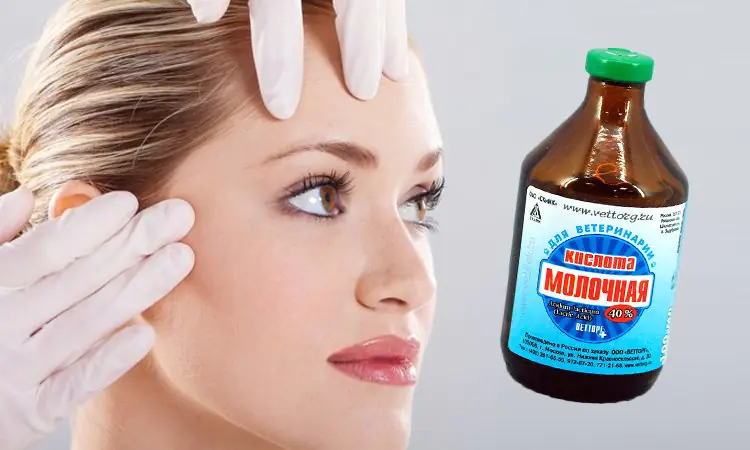
Lactic acid belongs to the group of AHAs or alpha hydroxy acids. It was first isolated and described by the famous chemist K.V. Scheele back in 1780. Then the Swedish scientist did not even imagine what contribution his discovery would make to maintaining the beauty and youth of women.
Surprisingly, our skin contains some lactic acid. Therefore, it is easily, without complications, perceived by cells during a cosmetic procedure.
The milk preparation actively affects the epidermal cells, weakens the protein bonds between them and accelerates the process of removing dead, non-working particles. The spaces freed from dead cells are replaced with new elastic elements. The end result is clear, soft, brightened and elastic skin.
Beneficial features
The acidic ingredient causes a large number of pleasant changes in skin cells:
- Protects against microbes, blocks inflammatory infections - the acidic environment it creates is destructive for bacteria and microorganisms;
- Replenishes lack of moisture, stabilizes pH balance;
- Effectively, without injury, gets rid of dead cells, normalizes the breathing of the integument;
- Partially smoothes wrinkles and prevents their appearance;
- Evens out the relief, the shade of the integument, gives the face lighter tones;
- Stimulates the regeneration process, stretch marks, scars and acne marks become less noticeable;
- Takes an active part in the treatment of acne and inflammation;
- Cleanses the skin from acne and comedones.
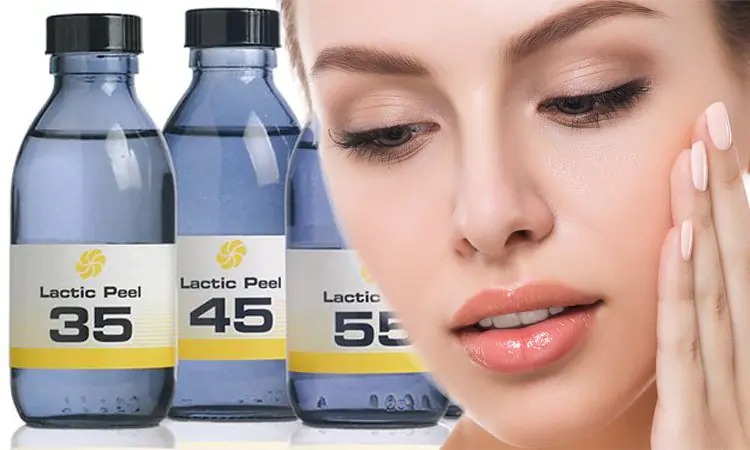
Lactic acid in cosmetology is considered a gentle acid, but this does not affect the final result. The drug is added to masks, creams, and milk peeling has completely conquered the women of the world.
Peels and cosmetics containing lactic acid are ideal for young patients, up to 35–40 years old. For women over 40 years old, they are weak; here you will find more suitable options for rejuvenation.
Indications and contraindications
Cosmetologists recommend using the drug for the following indications:
- Increased oily skin;
- Enlarged pores;
- Comedones;
- Dry skin, peeling;
- The first signs of aging of the integument;
- Small wrinkles in the eye area, lips;
- Decreased tone and skin turgor;
- Unusual pallor;
- Uneven shade of the epidermis, the presence of age spots;
- Frequent rashes, inflammation, pimples and acne.
Lactic acid gently eliminates skin problems. However, you must clearly understand that preventing a defect and eradicating it at the stage of its appearance is many times easier than fighting it in the future.
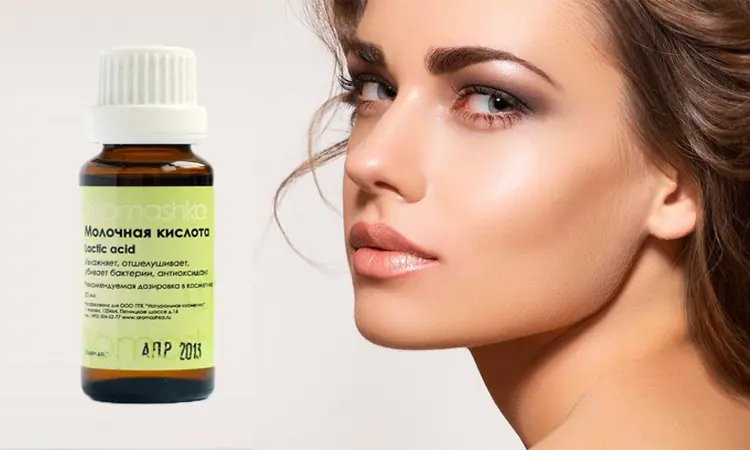
Not everyone is allowed to enjoy the effect of a dairy drug. It has a small list of limitations:
- Allergy to the drug;
- Active phase of herpes;
- Cuperosis;
- Infectious diseases;
- Purulent rashes on the face, prolonged inflammatory processes;
- Diabetes mellitus and cancer formations;
- Fresh wounds, abrasions on the treated area.
Allergy to lactic acid is a common phenomenon. Therefore, do not be lazy, do an allergy test before applying a cosmetic product.
Milk peeling
Peeling based on lactic acid is very popular in beauty salons. It gets rid of roughness and dirt from the skin, softens and moisturizes, and also stimulates the recovery process. Milk peeling for the face does not cause complications and does not irritate the skin. It should not be used after tanning, visiting a solarium, or sunbathing.
The essence of the procedure is to apply a concentrated acid solution to a previously prepared face. Aggressive particles of the drug destroy pollution, the structure of dead cells, and promote their accelerated regeneration. At the end of the procedure, an alginate mask with algae is applied. Seaweed is a whole complex of useful substances and microelements for the epidermis. If there is a lack of minerals and vitamin deficiency, withering, weakening of the tone of the integument, be sure to use kelp for the face.
During peeling, a concentrated milk solution is used. The content of the main ingredient depends on the sensitivity and degree of the problem, so it can vary between 30–90%.
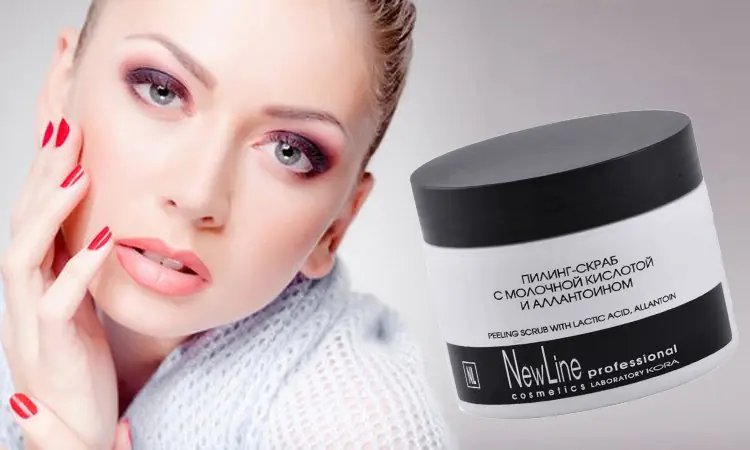
If you really don’t have enough time to visit beauty salons, then perform milk peeling for your face at home. All that remains is a small matter: buy a special product for the procedure, dilute it in a minimum concentration and, following all the rules for cleansing, apply it to the face. Cleaning the covers will take 10–40 minutes.
If, after milk peeling, redness appears that does not go away. Be sure to treat your skin with a proven cosmetic oil. Otherwise, consult a specialist for advice.
Homemade facial recipes
Lactic acid is a universal drug. It is used to prepare homemade masks, tonics, to enrich skin care creams, and for self-peeling. If it is not possible to purchase the ingredient, sauerkraut and milk will come to the rescue.
Compress mask for refreshing the face
To moisturize, soften the skin, lighten age spots and freckles, use a simple mask based on sour milk. After the procedure, you will notice a fresh, healthy complexion, the surface will become soft, elastic, and will look younger. To prepare the mask you will need:
- 4 tbsp. sour milk;
- 2 tbsp. oatmeal
Mix the ingredients until smooth. Prepare a small gauze bandage in several folds or use a bandage. Place part of the mask inside the bandage. Place the bandage on your face like a compress. After 20 minutes, remove the cloth and rinse with water.
Light facial toner
The dairy ingredient is found in homemade products. If you combine them correctly, you will get a simple but effective tonic in terms of moisturizing and softening the skin. To prepare a light tonic you will need;
- 2 leaves of fresh cabbage;
- 100 ml whole milk.
Chop the cabbage into small pieces. Bring the milk to a boil, pour it over the cabbage. Cover with a lid and leave warm for 30 minutes. Strain the liquid. The tonic is ready. Wipe your face with it several times a day throughout the week. The epidermis will become lighter and softer, the pores will partially narrow, irritability and redness will disappear. A slight lifting effect is possible.
Homemade peeling with milk
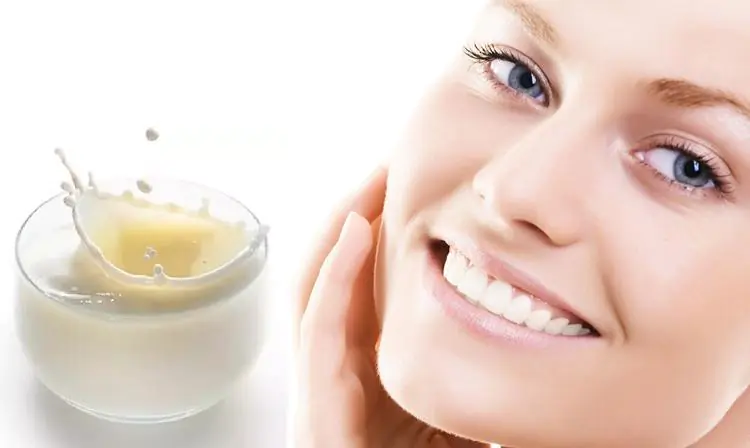
For the laziest, there is a simple option for cleansing your face with sour milk. No other ingredients are required. Apply a little sour milk to your cleansed face. Then repeat the procedure, only in a dense layer. After 15 minutes, rinse off any remaining product.
Rules and precautions for use
Concentrated lactic acid is a highly active substance used to cauterize warts. It can cause a chemical burn to the skin, causing redness and irritation. To protect yourself from such problems, follow simple rules:
- Before applying a mask or performing peeling, perform a rapid test for an allergic reaction;
- Do not use expired medications, formulations of questionable quality, or with damaged labels;
- Avoid getting cosmetics on the area around the eyes and mouth. In these areas, the skin is very sensitive and thin and requires a delicate approach;
- Acid peels are not recommended in spring or summer, so as not to cause hyperpigmentation;
- Gradually increase the concentration of the milk ingredient, starting with the minimum;
- If the concentration of the acidic ingredient exceeds 10%, then the composition should not contain retinol or its components. This combination increases the risk of irritation;
- To further soothe the skin and prevent irritation, use antioxidants and soothing ingredients. It would not be amiss to use a decoction of herbs for the face after the procedure.
Lactic acid, if used incorrectly, dries out the skin. After peeling, be sure to apply a nourishing, moisturizing mask.
The secret to the perfect appearance of famous models and actresses lies in high-quality skin care. Start with lactic acid. It acts very gently, is easily perceived by the epidermis, and does not cause discomfort or complications when used correctly.
Video
Peeling with lactic acid: technology.



